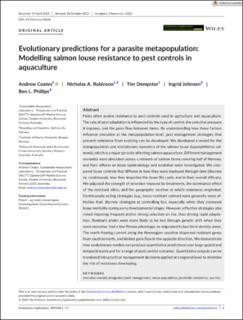| dc.description.abstract | Pests often evolve resistance to pest controls used in agriculture and aquaculture. The rate of pest adaptation is influenced by the type of control, the selective pressure it imposes, and the gene flow between farms. By understanding how these factors influence evolution at the metapopulation level, pest management strategies that prevent resistance from evolving can be developed. We developed a model for the metapopulation and evolutionary dynamics of the salmon louse (Lepeophtheirus salmonis), which is a major parasite affecting salmon aquaculture. Different management scenarios were simulated across a network of salmon farms covering half of Norway, and their effects on louse epidemiology and evolution were investigated. We compared louse controls that differed in how they were deployed through time (discrete vs. continuous), how they impacted the louse life cycle, and in their overall efficacy. We adjusted the strength of selection imposed by treatments, the dominance effect of the resistant allele, and the geographic location at which resistance originated. Continuously acting strategies (e.g., louse-resistant salmon) were generally more effective than discrete strategies at controlling lice, especially when they increased louse mortality during early developmental stages. However, effective strategies also risked imposing frequent and/or strong selection on lice, thus driving rapid adaptation. Resistant alleles were more likely to be lost through genetic drift when they were recessive, had a low-fitness advantage, or originated in low-farm-density areas. The north-flowing current along the Norwegian coastline dispersed resistant genes from south to north, and limited gene flow in the opposite direction. We demonstrate how evolutionary models can produce quantitative predictions over large spatial and temporal scales and for a range of pest control scenarios. Quantitative outputs can be translated into practical management decisions applied at a regional level to minimise the risk of resistance developing. | en_US |
